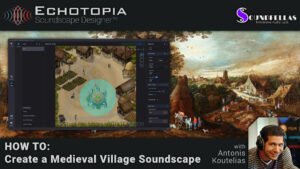By adhering to some simple rules, you can create a solid surround sound experience for your 2D game, that translates well in all possible speaker configurations and platforms. Those rules protect your game’s sound from falling into the common pitfalls that we discussed earlier in this article.
To do so we need to approach this through an organized grouping of the sounds based on their functionality, which is always my preferred way of organizing sounds in a project.
The grouping that I have chosen to use in our example is of the most common ones where the sounds are grouped as:
- Common sounds
- Big events
- Alerts
- Music
- Noise prints
Let’s take them one by one.
By the way, the screenshot of the game used in this article’s audio routing schematics is from “R-Type”, one of my favorite side-scrollers.
Common sounds
Common sounds from a 2D game are considered all the sound effects that are part of the action of the scene. Those do not include music, noise prints, alerts, and big world-altering events.
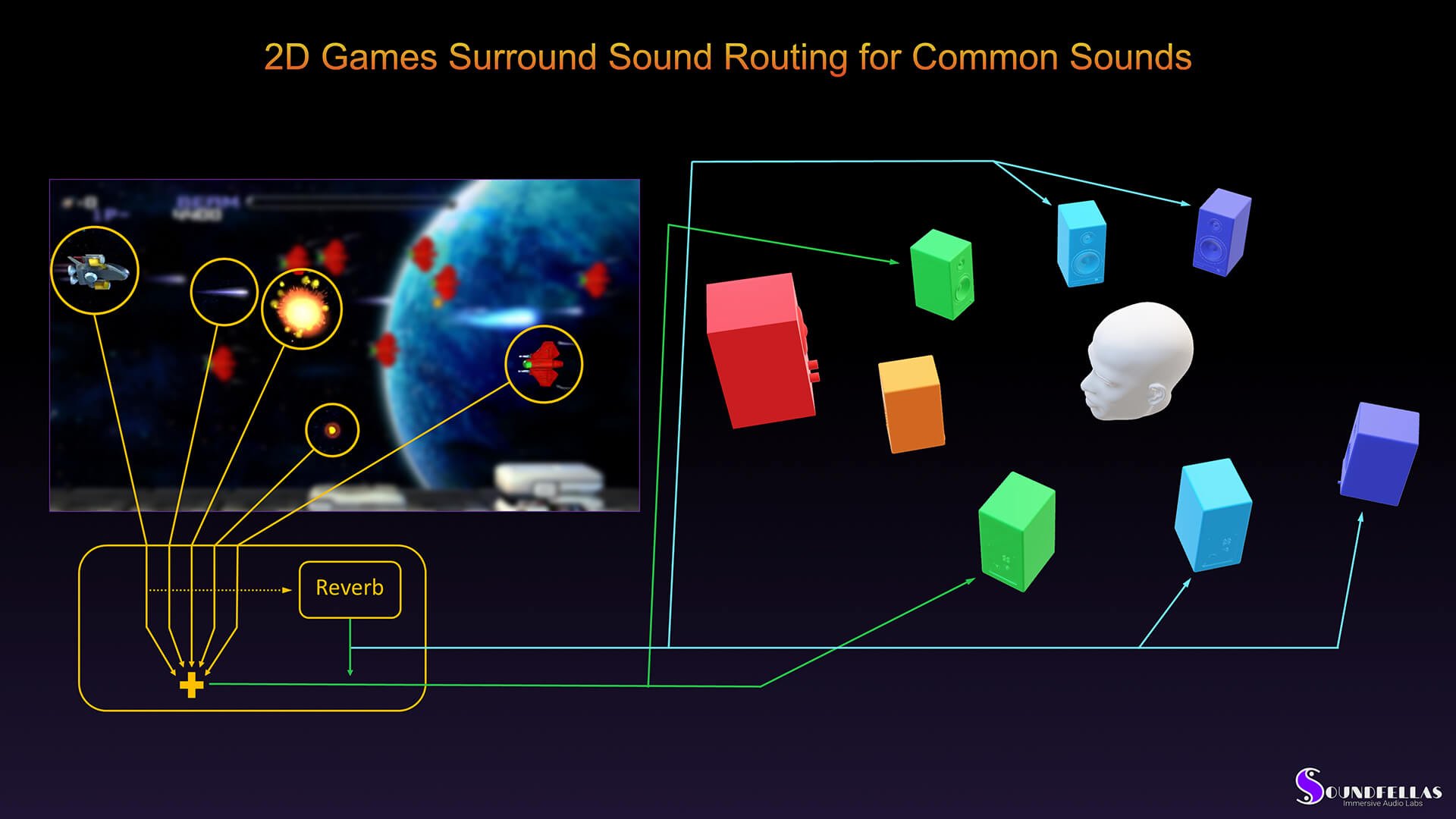
Common sounds consist a big part of the game’s audio content. I’m talking about the sound effects from weapons, footsteps, pickups, jumps, and all those sounds that are linked with common events of the game.
So an easy way to distinguish them from other sounds is to think for which event they are being played back in sync. If the event is common, then the sound should be probably considered a common one.
As we see from the image above, common sounds would be safe if:
- Played back from the main front left and right channels.
- A percentage of them is routed through the reverb that simulates the acoustic environment of the location ( level, room, or landscape) where the action takes place.
- The reverb output (sometimes also referred to as “wet”) is routed to the front speakers.
- The reverb output is routed to the back and side channels as well, to give the reflections a way to surround your players.
As you may notice, the common sounds are not routed at all to the front center or sub-channels. That is by design, to ensure the same experience with all playback scenarios.
Big events
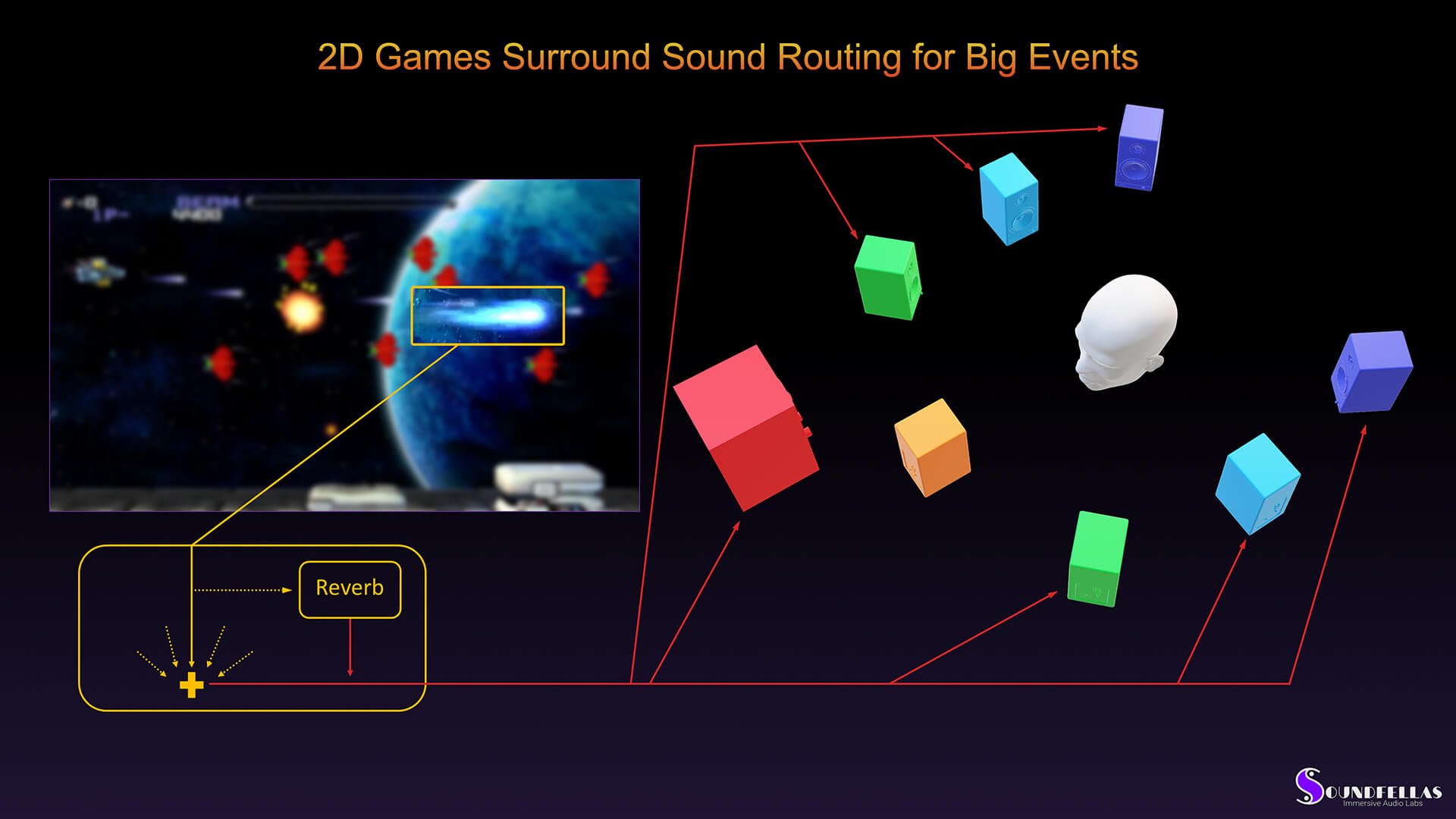
As you can read in the caption of the picture above, those are sounds coming from events that play a major role in the world, story, or general gameplay. Usually, those signify that something big just happened or something big is going to happen. That last one is my favorite. Using these kinds of sounds in your game can create unforgettable anticipation and raise the levels of adrenaline for the player in anticipation of something big happening. I still remember the sound of the spider approaching in Limbo that reminds me what a great game it is. So there you have it, use the big event tactic wisely together with sound and you will not regret it.
As we see from the image above, big events will be safe if:
- Played back from all the channels except the front center.
- A percentage of them is routed through the reverb that simulates the acoustic environment of the environment in which the action takes place.
- The reverb output is routed to all the channels except the front center.
As you may notice, the big events are not routed at all to the front center. That is again by design, to leave space for the sounds that are going to be routed in the front center channel. More on this later.
Alerts and notifications
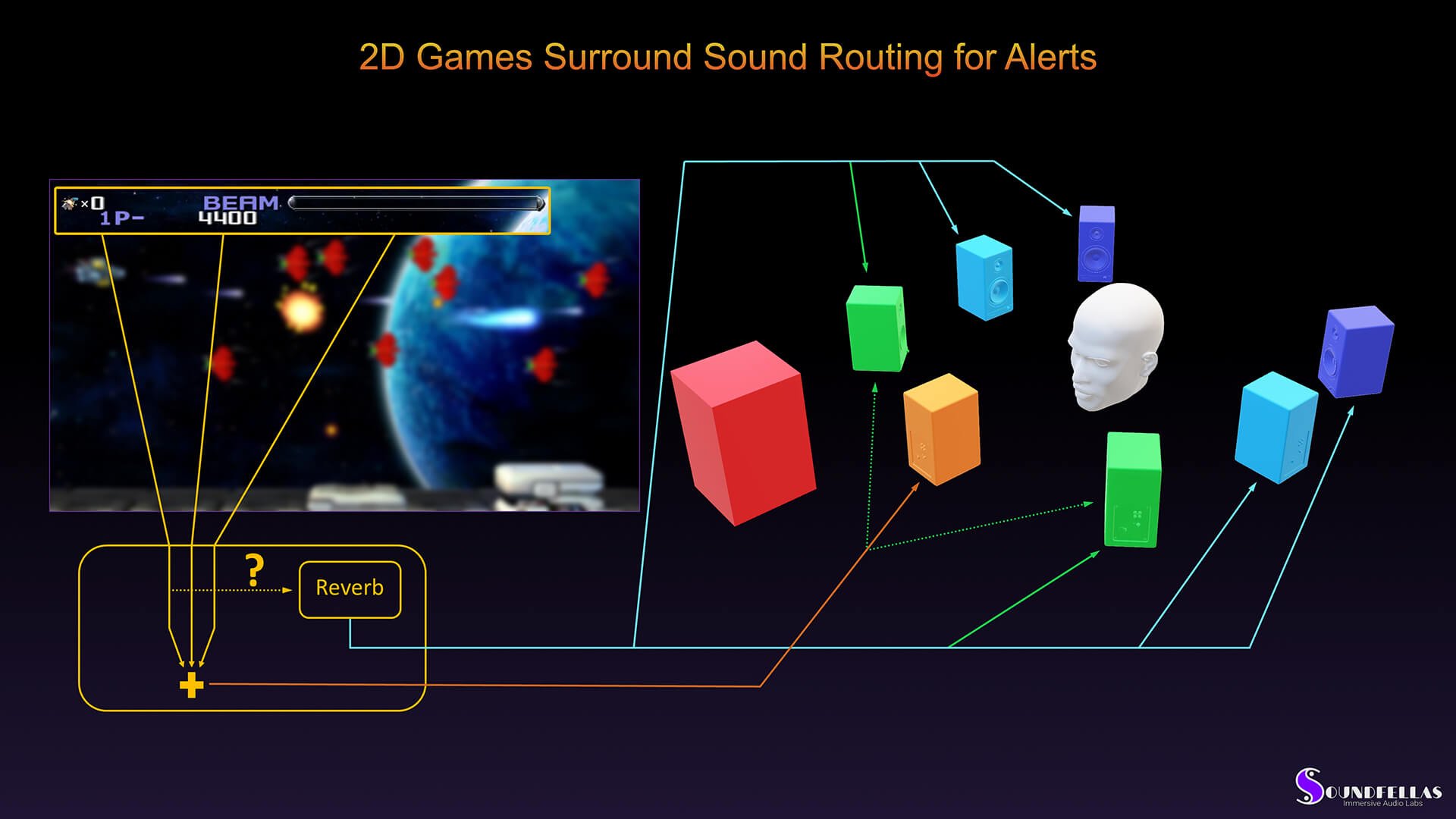
I consider alerts to be a special category that fits many kinds of sounds. By definition, they are sounds that should alert the player for something. But, if you think about it, every sound does just that. The footstep sound informs the player that the game character just made a step. Sounds from picking power-ups inform the player about the successful action of picking the power-up.
Alerts are sounds coming from events that are paramount to pass on to the user. Those are events that the user should really get feedback on clearly. In a shooting game, if the bullets end and the player should re-load the weapon, this is usually of paramount importance (unless by design it shouldn’t). These sounds also don’t vary much, are given directly, and require immediate action.
Voice should also be included in this category, that is why I don’t have a voice category in the proposed organization. With voice is easy to separate. If the voice is to inform the player, then it is an alert. If the voice is just a sound effect, then it is a common sound. There is also a common ground that we should mention here. When the voice is an alert that also has to carry localization information in the feedback to the player, like the voice of a zombie that you don’t see, but it is approaching the player. In this case, we have a hybrid, in which the sound is both a common sound and an alert. So, a middle solution should be used based on your game design and tests.
As we see from the image above, alerts would be safe if:
- Played back from the front center channel to be delivered as clearly as possible to the player.
- A good percentage of them is routed also in the front left and right channels, as safety when the front center channel is not available, or as in some bad cases, misconfigured. For example, the speaker holds the balcony door open during summer, or it’s a permanent side-stand for the bookshelf above the desk. 😛
At the schematic above you can see that I also use reverb to process a percentage of the alert sounds and rout that on the front, back, and side channels as well. But in the schematic, I also have a question mark at the send-bus to the reverb. This is because you should choose if that happens depending on whether the sound is diegetic or non-diegetic.
Diegetic
What “diegetic” means (and it doesn’t have anything to do with how many calories the sound contains per 100grams), is that the sound is taking place within the scene of action, so it is originating from the environment that the game’s action takes place. In that case, the sound should also pass through the reverberation simulation of the environment. That will make it fit with the rest of the game’s environment content.
Non-diegetic
On the opposite side, “non-diegetic” means that the sound is not originating from the environment where the game’s action takes place. Like the narrator's voice, we hear from “somewhere else” in various games and movies. In that case, the alerts should not pass through the game environment’s reverb simulation. In fact, these sounds should have their own separate reverb added, to highlight their origination from a world beyond.
This extra reverb output could be routed to all the channels and could be made to reflect the special case of the alert that we are hearing.
Here are some examples, just to give you an idea:
- The narrator in a high fantasy setting: Longer reverb as coming from a king’s throne hall, or short as coming from a cozy bedtime story setting.
- Player character’s inner voice (thoughts): Reverb with minimal reflectivity for the detective kind of stories, or reverb with long echoes if the character is reflecting the story from a future point in time. More reflection on the narrative, more reflection on the room reverb, kinda funny how things work sometimes, right?
- Alerts coming from the control center far away: Reverb that simulates the room of a high-end military control center, passed through a distortion module to add that walkie-talkie corruption we all love.
Music and noise prints
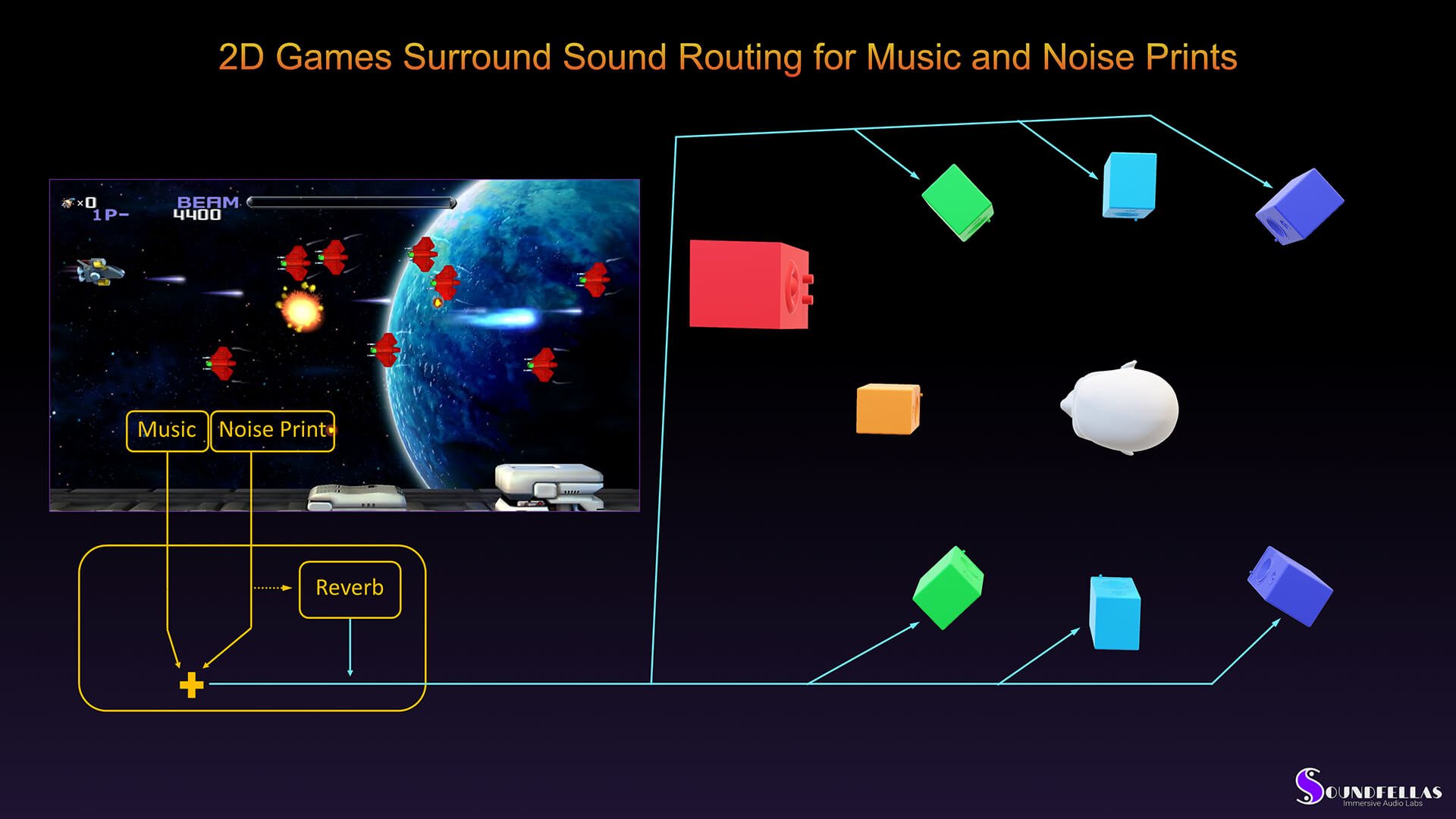
Music
Music is a very important part of any storytelling effort, no need to introduce or explain this content group.
As we see from the image above, music would be better if:
- Played back from all the channels except the front center and sub. That way we ensure that it surrounds the player.
- Has no relation to the environment’s reverb, unless it’s diegetic, in which case a percentage should go to the environment’s reverb and be routed to the same surround channels as the original (dry) content.
Of course, music should be produced to fit this philosophy. Many music tracks are usually produced in stereo which is not good for higher channel counts, as you don’t just route the stereo channels to the rest and expect it to work miracles. Also, music should be produced with a reverberation that fits the game’s aesthetic. There are some tricks that you could use, but that’s a big subject and will be included in a future article.
Our Production Music libraries actually include a quadraphonic surround version for all music tracks that are included in each library. That makes them ready for use in any surround channel configuration with simple drag-and-drop and if you wanna go to higher channel counts you can route the rear channels to the side channels and it will work nicely, as we mix them specifically with the game audio in mind.
Noiseprints
Noiseprints are treated the same as music with a small difference because they belong to the environment that action takes place in, so they should be:
- Played back from all the channels except the front center and sub. That way we ensure that it surrounds the player.
- Played back through the environment’s reverb processing and the wet should be routed to all the channels except the front center and sub.
Read why noiseprints are so important in our exclusive article Noiseprints or roomtones: The sounds all games need and how to use them.
We include noiseprints extracted from our environmental recordings for all our Ambience Kits, you should check them out.
Success
Surrounding the player with sound is always a good idea and can elevate any kind of game.
Conclusion
You may develop a game for devices that don’t support surround output, like smartphones and tablets. Or you may believe that most people play games using headphones. Either way, those two statements are not arguments against using surround sound output for your games. On the contrary, those two statements offer an argument on using surround sound. With the popularity of immersive audio that virtual reality brought to the digital entertainment media markets, some old but solid technologies were revitalized that allow for surround sound rendering through simple stereo headphones. Enter binaural audio rendering and its core algorithm HRTF (Head-Related Transfer Function).
Simply put, many software frameworks allow the developers to deliver their surround content to simple stereo headphones, while at the same time keeping the surround output, by rendering using a psychoacoustically calculated image that translates to a fully immersive format when delivered directly to the ears of the listener. The most popular ones at the time of writing are the Google Resonance Audio, Steam Audio, and Oculus Audio. Binaural auralization is also present in many game audio middleware software and tools like Fabric, Fmod, and Wwise to name a few. Of course, many game authoring solutions also support virtualized rendering multichannel audio to binaural format. You should read the documentation that is available for all those software solutions, to find the one that fits your business model and your project’s needs.
Even if you don’t support surround rendering for stereo headphones from within your game, there are also operating system plugins that allow the players to render your game’s surround sound output to binaural stereo, and enjoy that through their stereo headphones. For example at the time of writing, the two most popular for the Windows operating system are the Windows Sonic for Headphones and the Dolby Atmos for Headphones.
You can hear how immersive binaural stereo renders can be at the Google Resonance Audio SDK for the Web examples page.
With the power that most gaming devices feature, the optimization that current technologies offer, and some extra work from yourself, there is no excuse why your players should not enjoy a full surround sound experience. Either while playing through desktops with 7.1 speaker setups or through mobile devices using headphones, your players can enjoy a fully immersive experience, with the power of sound.
Surrounding the player with sound is always a good idea and can help you:
- Create more immersive experiences without depending on visuals.
- Make the audio layers of your game distinguishable: i.e. environment/alerts/narration.
- Gain devoted players that will come back for more.
In SoundFellas we utilize any technique that makes the sound more immersive, that is why we produce and deliver our Ambience Kits and Production Music libraries in all major channel formats (Stereo, Surround, and Ambisonic), specialized for use in audio for media production. We also offer the service of delivering other formats if needed, such as ambisonics, Dolby Atmos bed, Auro 11.1, Hamasaki 22.2, or even custom channel configurations (if you are interested, just contact us and tell us your needs). Furthermore, we create all our sound effect libraries ready to be incorporated within playback systems that use procedural techniques and randomized logic, for truly immersive game audio.
I believe that every developer with a little work at the beginning of the production can create easily translated surround sound experiences, which together with the new standards (i.e. Dolby Atmos, etc.) and the way you can link external devices (i.e. Philips Hue, etc.) with your games, can offer a new level of high-quality entertainment for the players in any gaming environment.
I hope this article will inspire the 2D game developers and motivate them to use surround sound for their games.
Success
Immersing your players inside the world of your game is easier with surround sound. Be it a full 7.1 living-room gaming setup, an enhanced subwoofer-equipped gaming laptop, or a smartphone with headphones, your players will surely appreciate it, and above all, enjoy it!
